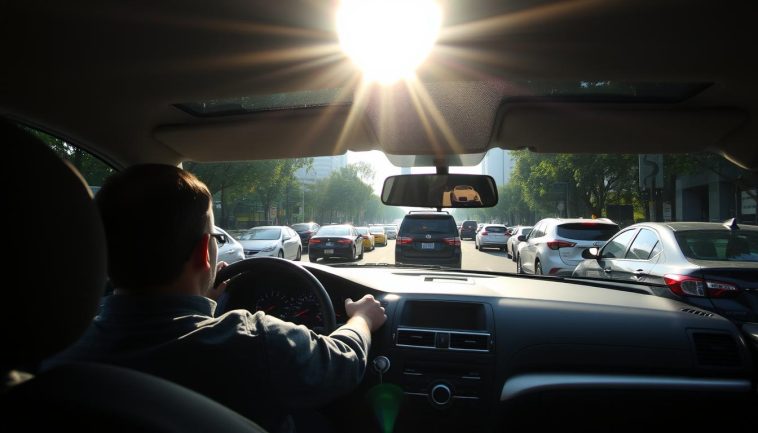anxietywhendriving.com highly recommends The Driving Fear Program to overcome your Driving Anxiety 90 Days Money Back Guarantee!
-->Click Here<--

Did you know that about 10% of people in the United States have a fear of driving, known as vehophobia? For those with this fear, driving in traffic can cause a lot of anxiety and panic. It can even make them avoid driving altogether, limiting their daily lives.
But there’s good news. With the right strategies and support, it’s possible to beat the fear of driving in traffic. This way, people can regain their freedom and independence.
Key Takeaways
- Driving phobia, or vehophobia, is a real condition that affects millions of Americans.
- A driving phobia can significantly impact one’s daily life, leading to isolation and reduced access to essential services.
- Fortunately, effective treatments are available to help those with a fear of driving overcome their anxiety.
- This article will explore the causes of driving anxiety, symptoms of a driving phobia, and proven strategies for conquering the fear of driving in traffic.
- By understanding the issue and taking proactive steps, it is possible to regain control and freedom on the road.
Understanding Driving Anxiety
Vehophobia is a specific phobia that makes people intensely afraid of driving. It’s a common anxiety disorder that affects many. It can make it hard to drive and leads to various fears.
What is Driving Anxiety or the Fear of Driving?
Driving anxiety, or the fear of driving, is a specific phobia. It’s an intense fear of driving a car. This fear can show up in different ways, like fear of accidents or losing control.
What Are Some Fears That People Have About Driving?
- Fear of getting into an accident
- Fear of losing control of the vehicle
- Fear of driving alone
- Fear of driving on highways
- Fear of driving over bridges or in tunnels
- Fear of driving in bad weather conditions
- Fear of driving after a previous accident
- Fear of judgement or criticism from other drivers
What Causes Fear of Driving?
The causes of driving phobia or vehophobia are complex. Some common reasons include:
- Being involved in or witnessing a car accident
- Experiencing panic attacks while driving
- Driving in risky or dangerous conditions
- Spending time around people who were fearful of driving during one’s youth
“Overcoming driving anxiety is a journey, but with the right strategies and support, it is possible to regain confidence and freedom on the road.”
Symptoms of Driving Phobia
Driving phobia can cause many physical and mental symptoms. These symptoms are part of the body’s natural response to danger. It’s called the fight-or-flight response.
Some common physiological symptoms of driving phobia include:
- Sweating
- Trembling
- Rapid and shallow breathing
- Shortness of breath
- Chest pain or tightness
- Increased heart rate
- Feeling dizzy or lightheaded
- Nausea or abdominal discomfort
- Tingling or numbness
People with driving phobia also have anxious thoughts and worries. They fear things like:
- Being in a severe accident or even dying
- Driving too fast and losing control of the car
- Feeling trapped inside the car
- Causing an accident and injuring others
- Being stranded on the side of the road
- Having a panic attack while driving
It’s key to know and understand these symptoms of driving phobia. This includes both physiological symptoms and anxious thoughts and worries. Knowing them is the first step to overcoming this fear. It helps you regain the freedom and independence of driving.
My Personal Journey Overcoming Driving Anxiety
Growing up, I saw my mom’s fear of driving. It made me scared too. News about car accidents made it worse. My first tries at driving were bad, with a flat tire and a close call with a pedestrian.
My Driving Anxiety
My fear of driving got worse. I started making excuses not to drive. Just thinking about driving made me tense and anxious. This fear really affected my life, making me less independent.
The Tipping Point: One day, I decided to drive
One day, I decided to face my fears. I used tips from articles and videos to help me. I knew I had to overcome my anxiety to take back control of my life.
My Journey
For two months, I started with short, easy routes. Then, I moved on to harder conditions and longer trips. I even drove from Boston to New York City. My first solo drive to work was a big win.
I kept pushing myself, learning to drive on the highway at night and even parallel park. It wasn’t easy, but beating my driving anxiety changed my life. I can now go where I need without fear. If you’re struggling with driving phobia, don’t give up. Seek help and start your journey to freedom on the road.
Overcome Fear of Driving in Traffic
Overcoming the fear of driving in traffic is tough, but doable with the right help. The author of this piece used a mix of methods to beat their driving anxiety. These methods can help others too.
The author started by working with a licensed therapist. They used cognitive behavioral therapy (CBT) and exposure therapy. Exposure therapy helped them face their fears in a safe way, building confidence.
They also took a driving course and practiced with a therapist or friend. This helped them improve their driving skills in a supportive environment. It made them feel less anxious.
Relaxation techniques, like meditation and breathing, were key for the author. These helped them stay calm and in control while driving. It was vital for managing their stress and anxiety.
Visualization was another important tool. The author imagined themselves driving calmly and safely. This mental practice helped them feel more confident and positive about driving.
“Overcoming my fear of driving in traffic was a gradual process, but with the right tools and support, I was able to regain my confidence on the road.”
The author’s success came from combining therapy, practice, relaxation, and visualization. This mix can help anyone facing driving-related fears.
Tips to Overcome Fear of Driving
Beating the fear of driving can change your life. It brings independence and ease. By looking at the benefits of driving, changing your mindset, and using relaxation methods, you can face the road with confidence.
List the Benefits of Being Able to Drive
Think about the good things about driving. It’s faster than public transport to work, school, and other places. It makes you feel safer, especially at night. Plus, you can carry more stuff and drive friends and family around.
List Your Specific Fears & Re-frame Your Thoughts
Identify what scares you about driving. It might be worrying about accidents, making others wait, or getting lost. Once you know, try to see these fears in a better light. Remember, most drivers want to be safe, people are understanding, and you can always find your way back.
Find Ways to Relax
Relaxation techniques help a lot. Try deep breathing before and during drives. Calming music can also help. Most importantly, be kind to yourself and stay positive.
| Relaxation Techniques for Driving | Benefits |
|---|---|
| Deep Breathing | Reduces stress and anxiety |
| Calming Music | Promotes a sense of tranquility |
| Positive Self-Talk | Boosts confidence and resilience |
By focusing on the benefits of driving, reframing your thoughts, and using relaxation techniques, you can beat your fear. This way, you can enjoy the freedom and convenience of driving.
“Driving is not just a means of transportation, but a journey of self-discovery and personal growth.”
Document Progress and Celebrate Milestones
As you work on overcoming your fear of driving, it’s key to track your progress and celebrate your wins. This keeps you motivated and boosts your confidence as you see your growth.
Start a driving journal. Write down where you went, how far, and any successes or challenges. Looking back at your journal shows how far you’ve come. It encourages you to keep going, even when it’s tough.
When you hit a big milestone, like driving on the highway or parallel parking, celebrate. You could treat yourself to your favorite snack or share it with someone you trust. These small wins help build your confidence and show you how far you’ve come.
Remember, overcoming driving anxiety is a journey, not a race. Every small step is worth celebrating. By tracking your progress and celebrating your milestones, you’ll gain the confidence to beat your fears and become a skilled driver.

Set Goals and Take One Step at a Time
Overcoming the fear of driving can seem hard, but setting attainable goals helps. Start small and gradually get better. This builds your confidence and skill.
First, decide what you want to achieve, like feeling okay driving anywhere. Break this big goal into smaller steps. For instance, start by driving to a nearby place during the day when it’s not busy.
Keep practicing this until you feel really comfortable. Then, you can try more challenging drives. This way, you’ll get better and more confident.
As you make progress, your confidence will grow. You can then tackle harder tasks, like driving further or in different conditions. By setting goals and taking it slow, you’ll beat your driving fear and become a skilled driver.
“The journey of a thousand miles begins with a single step.” – Lao Tzu
Don’t Aim for Perfection
When you’re learning to drive, it’s key to accept mistakes, learn from them, and keep things in perspective. Even seasoned drivers sometimes make mistakes. So, it’s okay if you do too.
Some common errors include turning the wrong way on a one-way street or missing an exit. You might also switch lanes too fast or have to stop suddenly. These mistakes are normal and help you learn.
The top drivers don’t aim for perfection. They accept mistakes happen and keep getting better. Trying too hard to be perfect can make you more nervous. Just focus on getting better at your own pace.
“Even the most experienced drivers make mistakes. The key is to learn from them and maintain a positive perspective.”
So, accepting mistakes, learning from them, and keeping a positive outlook are key to beating driving fear. With patience and a realistic view, you’ll become a safe and confident driver.
Talk to Others About Your Fears
Overcoming the fear of driving is tough, but you don’t have to face it alone. Talking about your fears with friends, family, or a support group can help. You might find out you’re not the only one who struggles with driving anxiety.
Many drivers, even those who look confident, have battled driving phobia. Hearing how others have overcome their fears can offer peer support and motivation. It shows you’re not alone, which can be very comforting.
Once You Start Driving, Continue to Drive Whenever You Can and Don’t Stop
After you start driving, keep going consistently. Don’t let fear make you stop driving, as it can undo your progress.
- Try to drive as much as you can, even for short trips. The more you drive, the more comfortable you’ll get.
- Celebrate your small wins and don’t be too hard on yourself if you have setbacks. Overcoming driving fear is a journey that takes patience and kindness.
Sharing your experiences and driving regularly can help you beat the fear of driving in traffic. With peer support and consistent practice, you can become a confident driver and enjoy the freedom that comes with it.

Conclusion
Overcoming driving anxiety is a tough but rewarding journey. It involves addressing the fear’s roots, using practical strategies, and keeping a positive mindset. This way, people can regain the freedom and independence of driving.
The author’s story and the tips in this article offer a path for those facing driving fears. They help understand triggers and celebrate small victories. These steps empower people to face their fears and take control of their lives.
The author wants this article to inspire and help others. They encourage seeking support, like therapy or talking to friends. By focusing on mental health and taking small steps, people can beat their driving fears. This way, they can enjoy the freedom and independence driving offers.
FAQ
What is driving anxiety or the fear of driving?
Vehophobia is a phobia that makes people very afraid of driving. It’s an anxiety disorder. The fear is much bigger than the actual danger of driving.
What are some common fears that people have about driving?
People often fear accidents, losing control, or driving alone. They might also worry about driving on highways, over bridges, or in tunnels. Bad weather or driving after an accident can also cause fear. Some fear what others might think.
What causes the fear of driving?
Being in a car accident or seeing one can cause fear. Panic attacks while driving are another reason. Driving in bad conditions or being around fearful people can also contribute.
What are the symptoms of driving phobia?
Symptoms include sweating, trembling, and rapid breathing. You might feel dizzy, have chest pain, or nausea. Anxious thoughts about driving dangers are common too.
How can you overcome the fear of driving in traffic?
Cognitive behavioral therapy and exposure therapy can help. Taking a driving course and practicing relaxation techniques are also important. Visualization, setting goals, and staying positive are key.
What are some tips for overcoming the fear of driving?
List the benefits of driving. Reframe your fears and find ways to relax. Talking about your fears can also help.
Is it important to document progress and celebrate milestones when overcoming the fear of driving?
Yes, documenting your progress and celebrating milestones helps. It shows your success, boosts confidence, and keeps you motivated.
Should you aim for perfection when overcoming the fear of driving?
No, don’t aim for perfection. Mistakes happen, even for experienced drivers. Learn from them and stay focused.
Is it important to continue driving once you’ve started overcoming your fear?
Yes, keep driving as much as you can. Stopping and starting too much can make anxiety worse. Regular practice builds confidence and skills.
anxietywhendriving.com highly recommends The Driving Fear Program to overcome your Driving Anxiety. 90 Days Money Back Guarantee!
-->Click Here<--

